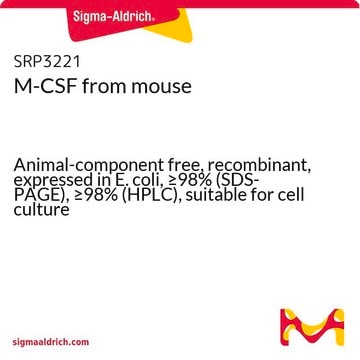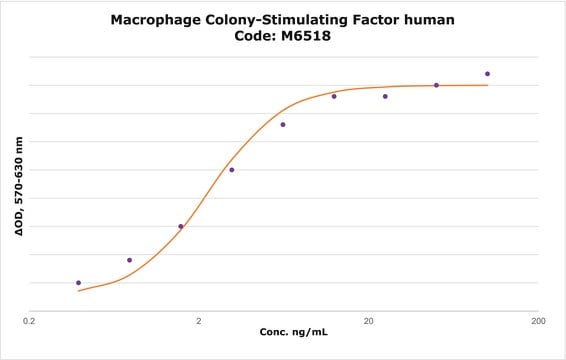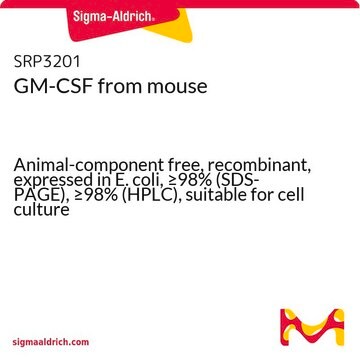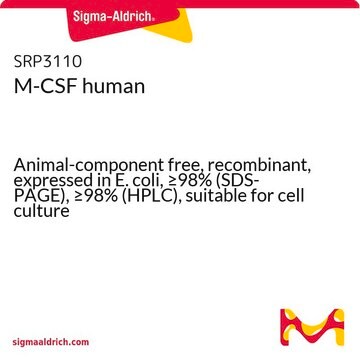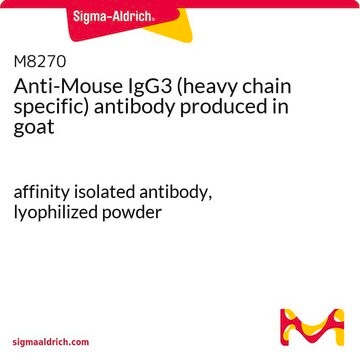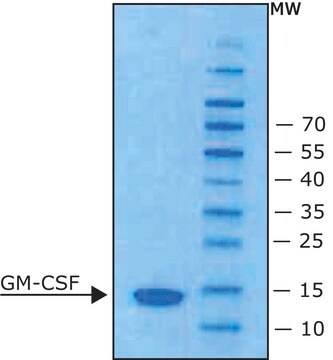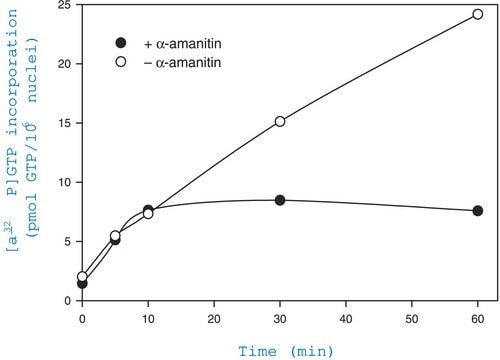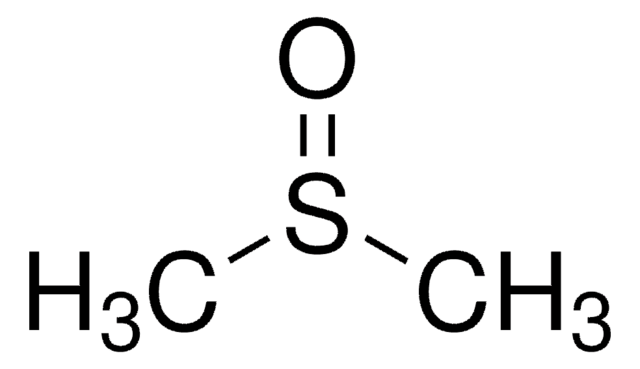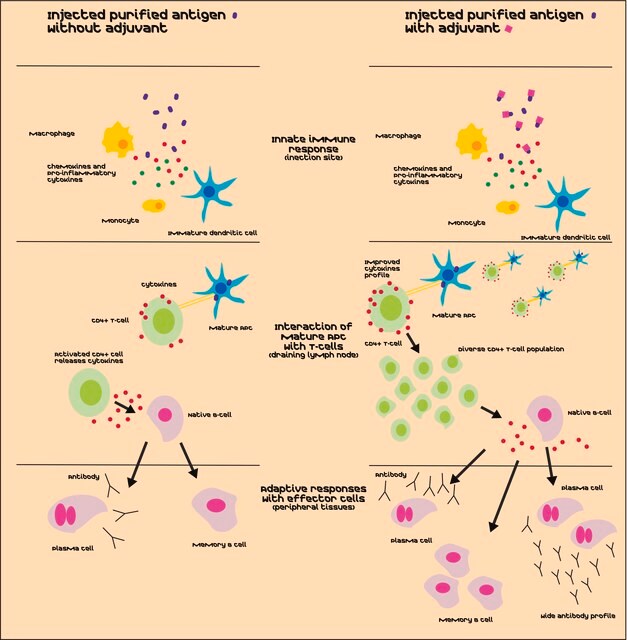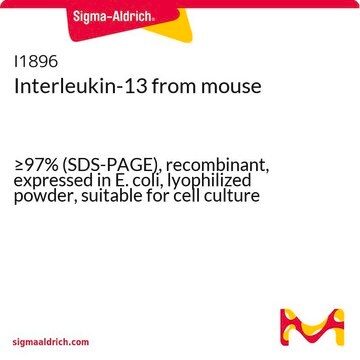M9170
Macrophage Colony-Stimulating Factor from mouse
≥98% (SDS-PAGE), recombinant, expressed in E. coli, lyophilized powder, suitable for cell culture
동의어(들):
mCSF-1, mM-CSF, CSF-1, M-CSF
로그인조직 및 계약 가격 보기
모든 사진(2)
About This Item
CAS Number:
EC Number:
MDL number:
UNSPSC 코드:
12352202
eCl@ss:
32190102
NACRES:
NA.77
추천 제품
제품명
Macrophage Colony-Stimulating Factor from mouse, M-CSF, recombinant, expressed in E. coli, lyophilized powder, suitable for cell culture
생물학적 소스
mouse
Quality Level
재조합
expressed in E. coli
분석
≥98% (SDS-PAGE)
양식
lyophilized powder
효능
0.500-3.000 ng/mL ED50
품질
endotoxin tested
분자량
dimer 18.2 kDa (containing 156 amino acid residues)
포장
pkg of 10 μg
기술
cell culture | mammalian: suitable
불순물
≤1.000 EU/μg
색상
white
UniProt 수납 번호
저장 온도
−20°C
유전자 정보
mouse ... Csf1(12977)
유사한 제품을 찾으십니까? 방문 제품 비교 안내
애플리케이션
Macrophage Colony-Stimulating Factor from mouse has been used:
- in the initiation of osteoclastogenesis in bone marrow monocyte cells
- to stimulate osteoclast differentiation in non-adherent hematopoietic cell
- for the generation of blood-derived stem cells
생화학적/생리학적 작용
Macrophage Colony Stimulating Factor (M-CSF), also known as CSF-1, can be produced by a number of cells, including fibroblasts, monocytes, activated macrophages, secretory epithelial cells of the endometrium, endothelial cells activated by LPS or cytokines, and bone marrow stromal cells. In addition to its namesake activity, M-CSF can stimulate the proliferation of isolated macrophages, augment the production and release of cytokines and other inflammatory modulators from macrophages, enhance macrophage antibody-dependent cell-mediated cytotoxicity, prime and enhance macrophages in their ability to kill tumor cells and other microorganisms, stimulate pinocytosis, and support osteoclast differentiation. M-CSF binds and activates a 165 kDa glycoprotein of the receptor tyrosine kinase subclass III or the RTK subfamily. Due to alternative splicing of a single M-CSF gene and due to variations in glycosylation, the molecular weight of natural soluble M-CSF ranges from 44-86 kDa. Human and mouse M-CSF share approximately 80% sequence homology in the conserved N-terminal region of 150 amino acids. Although human M-CSF is active in murine systems, mouse M-CSF appears to be species-specific in its actions.
Macrophage Colony Stimulating Factor (M-CSF), also known as CSF-1, can be produced by fibroblasts, monocytes, activated macrophages, secretory epithelial cells of the endometrium, endothelial cells activated by LPS or cytokines, and bone marrow stromal cells. In addition to its namesake activity, M-CSF augments many of the physiological functions of macrophages, and support osteoclast differentiation. M-CSF binds and activates a 165 kDa glycoprotein of the receptor tyrosine kinase subclass III or the RTK subfamily. Due to alternative splicing and glycosylation the molecular weight of natural soluble M-CSF ranges from 44-86 kDa. Although human M-CSF is active in murine systems, mouse M-CSF appears to be species-specific in its actions.
물리적 형태
Lyophilized from a sterile filtered buffered aqueous solution.
분석 메모
The proliferative activity is tested by the dose-dependent stimulation of the murine monocytic cell line, M-NFS-60.
신호어
Warning
유해 및 위험 성명서
예방조치 성명서
Hazard Classifications
Eye Irrit. 2 - Skin Irrit. 2 - STOT SE 3
Storage Class Code
11 - Combustible Solids
WGK
WGK 2
Flash Point (°F)
Not applicable
Flash Point (°C)
Not applicable
개인 보호 장비
dust mask type N95 (US), Eyeshields, Gloves
이미 열람한 고객
Elisabeth A Diget et al.
Mediators of inflammation, 2013, 208412-208412 (2013-02-23)
Macrophages play an important role in human immunodeficiency virus (HIV) pathogenesis and contribute to establishment of a viral reservoir responsible for continuous virus production and virus transmission to T cells. In this study, we investigated the differences between various monocyte-derived
B F Boyce
Journal of dental research, 92(10), 860-867 (2013-08-03)
Osteoclasts are derived from mononuclear hematopoietic myeloid lineage cells, which are formed in the bone marrow and are attracted to the bloodstream by factors, including sphingsine-1 phosphate. These circulating precursors are attracted to bone surfaces undergoing resorption by chemokines and
Filamin A regulates monocyte migration through Rho small GTPases during osteoclastogenesis
Leung R, et al.
Journal of Bone and Mineral Research, 25(5), 1077-1091 (2010)
Strain differences in the attenuation of bone accrual in a young growing mouse model of insulin resistance
Rendina-Ruedy E, et al.
Journal of Bone and Mineral Metabolism, 34(4), 380-394 (2016)
Yan Li et al.
Journal of immunology (Baltimore, Md. : 1950), 191(6), 3192-3199 (2013-08-13)
Engraftment of human CD34⁺ hematopoietic stem/progenitor cells into immunodeficient mice leads to robust reconstitution of human T and B cells but not monocytes and macrophages. To identify the cause underlying the poor monocyte and macrophage reconstitution, we analyzed human myeloid
자사의 과학자팀은 생명 과학, 재료 과학, 화학 합성, 크로마토그래피, 분석 및 기타 많은 영역을 포함한 모든 과학 분야에 경험이 있습니다..
고객지원팀으로 연락바랍니다.